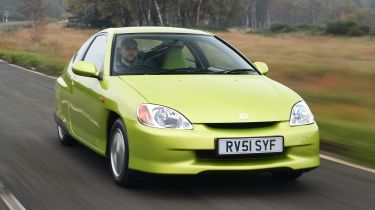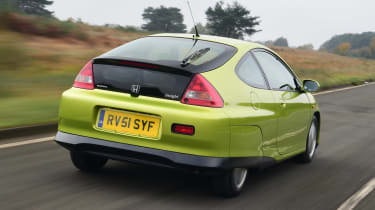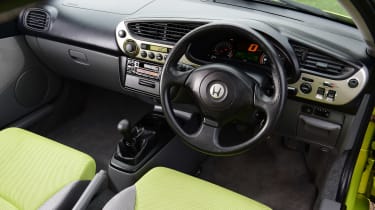Honda Insight (Mk1, 1999-2006) icon review
We take a second look at the pioneering Honda Insight in Mk1 form
It’s easy to think of hybrid cars as a relatively recent thing. But while their widespread adoption might have only happened in the past few years, the oldest mainstream production hybrids are now a quarter of a century old.
At the forefront of this push were the original versions of the Toyota Prius and the star of this feature, the Honda Insight. The much more radical of the two, it wears its eco credentials on its sleeves. Every part of it seems designed to eke out the best economy possible; the Insight is a far more ‘pure’ take on hybrid driving than the average heavy PHEV SUV rolling on huge wheels.
Here, there are 14-inch wheels shod in super-skinny 165-section low rolling-resistance tyres, and the rears are partly hidden under wheel spats and sit 110mm further inboard than the fronts, to lower drag. The spats aren’t a token afterthought, either, because the whole body was designed to be as slippery as possible, with a teardrop shape giving a drag coefficient of just 0.25Cd, while resulting in a car that looks like a retro-futuristic spaceship.
The main structure, body panels, wheels and a lot of the suspension components are made from aluminium. There’s even magnesium used in the engine to trim the fat, and there are no rear seats. This results in a car weighing 835kg.
Used - available now

2020 Land Rover
Discovery Sport
24,114 milesAutomaticDiesel2.0L
Cash £25,960
2023 Tesla
New Model Y
20,490 milesAutomaticElectric
Cash £26,697
2021 Audi
Q3
55,755 milesAutomaticPetrol2.0L
Cash £20,197
2020 Jeep
Compass
70,901 milesManualDiesel1.6L
Cash £11,197A light vehicle doesn’t need much power to keep it moving, so Honda fitted the Insight with a 1.0-litre three-cylinder engine, years before the use of three-pots in the car industry became commonplace. It’s backed up by a 13bhp motor and a 12-volt nickel metal-hydride battery pack, for a total output of 72bhp and official economy of 69mpg.
Speak to a few owners, and they’ll tell you the Insight is good for much more – 80-90mpg, if you’re careful, and 100mpg isn’t unheard of. This we can believe, because by the time we arrived at the shoot location, about half an hour away from where we picked the car up, the figure was at 60mpg and was climbing.
These days we’re used to clever animations in digital instrument clusters telling us all about a hybrid car’s energy flow, but the simple set-up in the Insight in its S2000-esque gauge cluster works just as well. A series of backlit segments show if the battery is being charged or providing assistance, along with the overall charge level of the battery. There’s also a shift indicator telling you when to change to a higher gear for better efficiency.
This tells you to do so very early, often at little more than 1,500rpm. Follow it, and progress is especially sluggish, but given the modest level of power on offer and the long-geared five-ratio transmission, the Insight never feels even remotely fast, despite its low weight.
When it comes to changing gear, the shift quality feels pleasant and accurate, while the pedal action is light. It’s fairly softly sprung, giving a comfortable ride quality but also quite a bit of body roll. Yet when the car changes direction, you can feel just how light it is. There’s precious little life in the steering, which we can attribute to the Honda having a very early electrically assisted set-up.
You’d think the noise of that inline-three revving its heart out might get a bit much, but you’re kept well insulated from it, save for some rattles at idle, which are passed into the cabin. There is a reasonable amount of road noise at cruising speeds, which seems inevitable, because Honda wouldn’t have gone to town on the soundproofing here.
It’s an intriguing car to drive, rather than an exciting one. It’s also fun watching the hybrid display showing the power management in action, and seeing the reflection from white paint on the road surface flashing by as reflections in the domed rear windscreen. The cabin is a simple affair on the whole, livened up with the same steering wheel found in the S2000, albeit wrapped in plastic rather than leather.
While Toyota just beat Honda in terms of starting production, the Insight landed in the UK first, and the Honda had the edge in terms of technical innovation. It was certainly the more interesting of the two, and remains so; the Prius is a charisma vacuum by comparison.
It’s the Honda which ended up with the cult appeal. You need to pay at least £7,000 for a decent Insight these days, whereas an early Prius can be bought for buttons. But the Insight’s extra verve didn’t result in more sales. Throughout its life, the Toyota outsold the Honda many times over. The Insight was just too ‘out there’ for its own good; a quirky shape, a lack of practicality with only two doors and two seats combined with a high price counted against it.
It also wasn’t the easiest thing to build. Honda made the Insight at its Takanezawa plant in Tochigi – known for building halo products such as the NSX and S2000 – where its aluminium-intensive construction made it expensive to make. Nearer the end of its life, production shifted to Suzuka, with Honda only ever building the car in low numbers.
Production finished in 2006, and it wouldn’t be until 2009 that the second-generation Insight arrived. Honda didn’t make the same mistake twice, coming up with something conspicuously more conventional than the original. It sold better than the Mk1, but not anywhere near strongly enough to stop the Prius-vs-Insight rivalry looking awfully one-sided towards Toyota’s corner.
The Mk2 Insight bowed out in 2014, with the name yet to return to the Honda stable. The Prius, on the other hand, is now in its fourth generation, with the fifth version revealed very recently. It’s a shame the Insight’s story ended, because right now, a car as dogmatically focused on extracting the best MPG possible as the original is something we could really do with. For now, you’ll find me with my nose buried in the classifieds.
What we said then
- Issue 575, November 1999
“Honda’s Insight brings a glimpse of the future to today’s showrooms. It should prove encouraging for buyers, because this car tells us we needn’t drive dull machinery to do our bit for the future. Perky to drive, easy to live with, interesting-looking and practical to boot, it’s a step in the right direction.”
Interested in buying one?
Your main problem with the Insight is finding one to buy in the first place. Its slow sales mean there are rarely more than a handful for sale across the whole country, and the few that are around have been commanding ever-stronger money in recent years.
The aluminium construction means rust should be less of an issue than in the average 20-or-so-year-old car, but that’ll be offset by higher repair costs in the event of damage. Certain Insight-specific components may also prove difficult to come by.
You should always keep the health of the battery cells in mind, so use the car regularly to keep them working properly. An IMA (Integrated Motor Assist) light on the dash could indicate an issue and battery replacement is costly. The Insight does function if the pack dies, because there’s a 12-volt battery to power the car’s ancillaries. Some owners replace the nickel-metal hydride battery with lithium ion, but this is a far more expensive process.
| Model: | Honda Insight Mk1 |
| Production dates: | 1999-2006 |
| Price then: | From £17,000 |
| Price now: | From £7,000 |
| Engine: | 1.0-litre 3cyl petrol |
| Power/torque: | 72bhp/91Nm |
| Transmission: | 5-speed manual (with CVT option from 2001), front-wheel drive |
| 0-62mph: | 12.5sec |
| Top speed: | 112mph |










